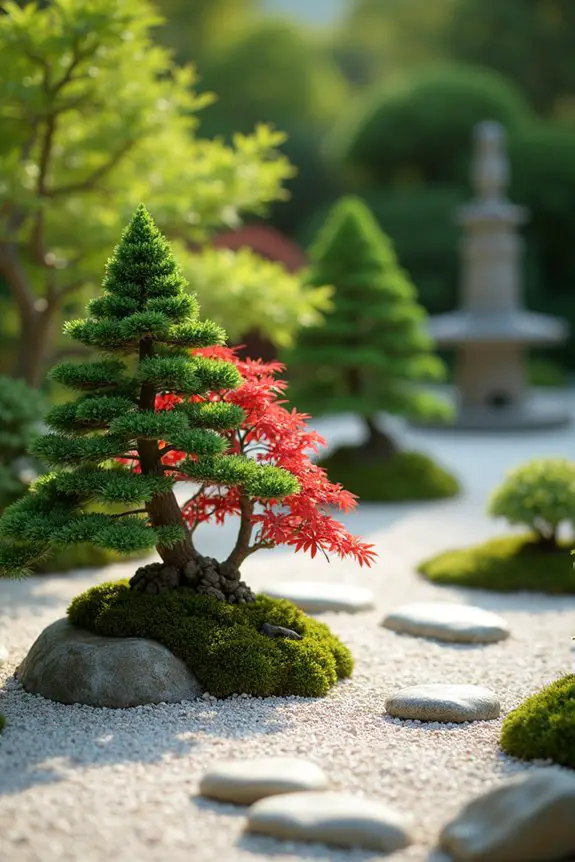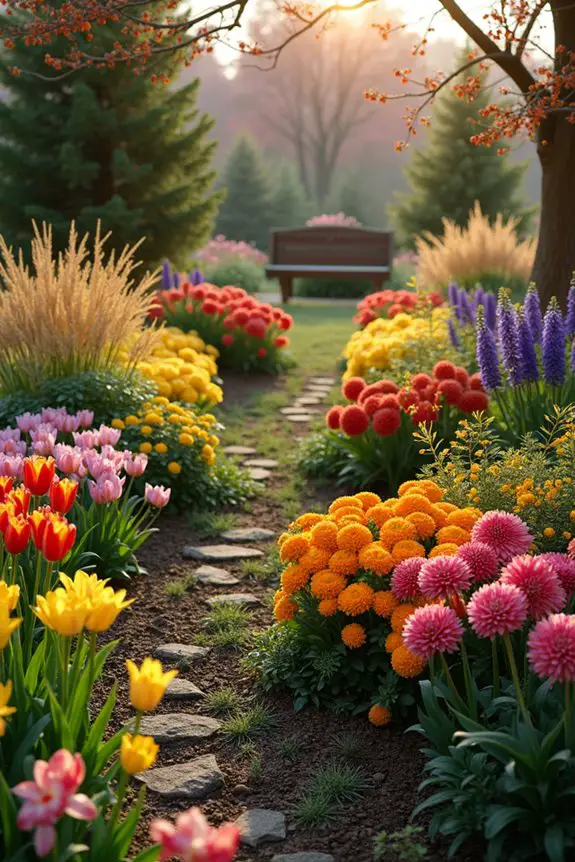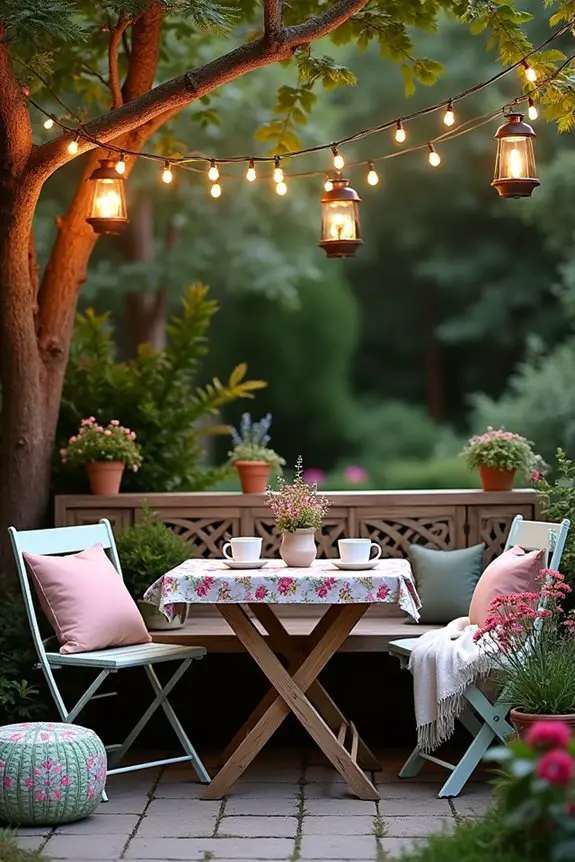Thinking about creating your own Japanese garden? It’s all about finding that perfect balance between nature and design. Picture yourself wandering along pathways lined with miniature trees, their tranquil branches whispering in the breeze. You’re not just creating a space; you’re crafting a peaceful retreat. Sure, it sounds easy, but trust me, there’s a bit more finesse involved. Want to know how to nail those bonsai arrangements and water features? Let’s explore the art of simplicity together.
Miniature Tree Arrangements
When it comes to miniature tree arrangements, think about how a bonsai tree can take center stage in your garden.
You’ll be amazed at how these little beauties can add a touch of elegance and tradition, all while fitting into snug spaces.
Have you ever tried arranging them? It’s kind of like putting together a tiny puzzle, and trust me, it’s way more satisfying than it sounds.
1. Bonsai Tree Placement

Bonsai trees aren’t just plants; they’re like little sculptures that breathe life into your space. They fit perfectly in tight spots and create an ambiance that whispers tranquility.
Imagine walking into a room and being greeted by a serene little tree that transports you to a peaceful Japanese landscape. It’s a vibe you can’t resist.
When placing your bonsai, think about the levels of light and the layout of the room. Start with a spot that gets indirect sunlight; direct sun can be too harsh for these delicate beauties. Consider using a liquid fertilizer dispenser to ensure your bonsai receives consistent nourishment.
If you don’t have a lot of space, a windowsill or a small tabletop works wonders. Picture your bonsai sitting there, its tiny branches reaching upward, inviting you to take a moment and just breathe.
Try arranging multiple bonsai together in different heights. This adds depth, kind of like a mini forest right in your living room. Sounds fun, doesn’t it?
But be careful not to crowd them. Give each tree some room to shine. You want them to feel spacious, not cramped—like you after a holiday feast, right?
And speaking of style, you could switch things up with decorative pots. Consider earthy tones or simple, elegant designs that complement the tree’s textures.
A pop of color in the pot can also bring a playful touch, just like your favorite sweater that unexpectedly brightens a gloomy day.
Finally, there’s nothing wrong with a little personal touch! Don’t hesitate to give your bonsai a name or even a backstory.
It just makes you feel more connected to your little green companion—like they’re not just plants, but part of the family. Additionally, using orchid rooting hormone can enhance the growth of your bonsai by ensuring strong root development.
2. Bonsai Tree Aesthetics
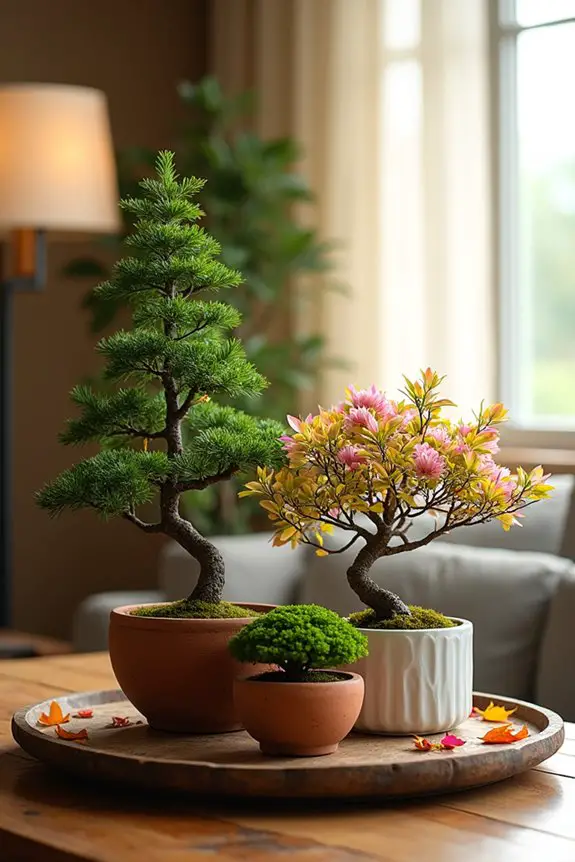
When it comes to designing a space with bonsai trees, think of it as crafting a serene little world right in your living room. These tiny masterpieces can do a lot more than just sit pretty; they can add character and breathe life into any corner, making the area feel more inviting and calm.
Let’s get creative. Picture a grouping of three bonsai, each with its own unique shape and size, arranged on a simple wooden tray. This not only creates a focal point but also adds layers and depth to your display. You might have a tall, slender tree next to a more rounded one—kind of like a mini family reunion. Just remember to leave enough space between them. You wouldn’t want your trees fighting for attention, like your pets trying to steal your dinner.
Now, consider the pots. Instead of just grabbing any old plant container, why not go for something that tells a story? A rustic clay pot for one and a sleek ceramic one for another could create an engaging contrast. It’s all about mixing textures—smooth against rough—and playing with colors that complement both the tree and the surrounding décor. It’s like dressing up for a dinner party, but instead, you’re dressing your little trees. Choosing the right container can also help in managing bonsai humidity levels, ensuring your trees thrive.
Don’t forget lighting! A strategically placed lamp or a spot by the window can highlight the elegant branches and lush leaves, making them pop and drawing the eye right where you want it. Think of it as the spotlight at a concert, shining down on your star performers.
Lastly, embrace the idea of seasonal changes. You might switch out the displays based on the time of year. Imagine a whimsical autumn theme with fallen leaves sprinkled around your bonsai, giving it a cozy, festive touch. You’ll not only enhance the visual appeal of your space but also draw your guests into a seasonal story filled with warmth. Adding bonsai moss top dressing can further enrich the overall aesthetic and provide a lush environment for your trees.
3. Bonsai Aesthetic Integration
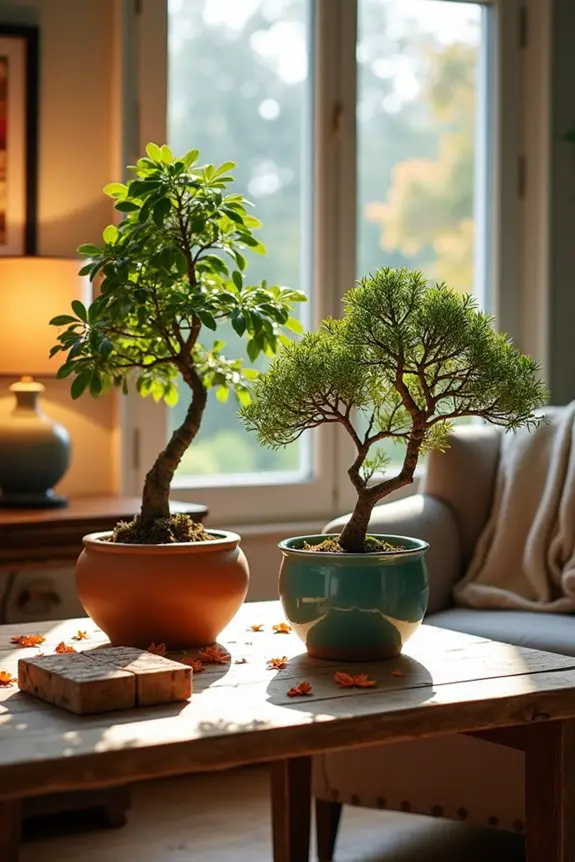
Imagine stepping into a room where miniature trees dance delightfully on shelves and tables, each one a story of nature’s grace captured in just a few inches. Integrating bonsai trees into your space not only adds a pop of tranquility but also creates a unique style that merges nature with your home. It’s like bringing a little piece of a Japanese garden indoors—who wouldn’t want that soothing vibe?
Start with placement. Find corners or surfaces that are just begging for something special. Maybe it’s that awkward spot next to the couch or the bare tabletop that looks lonely. Group your bonsai trees in threes or fives. Why? Because odd numbers are visually pleasing, and they help to create a natural, flowing look. Trust me, it’s much more appealing than having a lineup of even-numbered trees, standing like soldiers ready for inspection.
Next up, let’s talk about the pots—this part can be a little fun. You could go with classic, earthy textures like terracotta or mix things up with bright, colorful ceramics. Picture a rustic brown clay pot next to a shiny teal one; the contrast adds a playful dimension. Ensuring you have the right bonsai pruning tools will help in maintaining your trees’ health and beauty.
Just remember, don’t crowd them too close together. Each tree deserves its space, much like we all appreciate personal bubble zones—well, most of the time anyway.
Now, on to the lighting. Here’s a little secret: bonsai love the spotlight. A well-placed lamp or a sunny windowsill will help show off their delicate branches and vibrant foliage. Think of it like creating a stage—a cozy little arena where your trees can shine and charm everyone who walks by. If they’re flourishing, you’re bound to draw more compliments than Aunt Betty after her famous lasagna.
Finally, don’t shy away from seasonal flair. Why stick to the same old look? Explore different themes throughout the year. In fall, sprinkle some faux leaves around your bonsai setup, and in winter, maybe a couple of mini ornaments could do the trick.
It’s not just a tree display; it’s your own little art installation that tells a seasonal story.
There you have it! A simple guide to integrating bonsai trees into your space can transform the ordinary into the extraordinary, while nurturing that calming, Zen feeling we all crave in our fast-paced lives. Plus, it gives you a lovely reason to keep your space neat—because no one wants to put the spotlight on dust bunnies.
4. Bonsai Integration Techniques
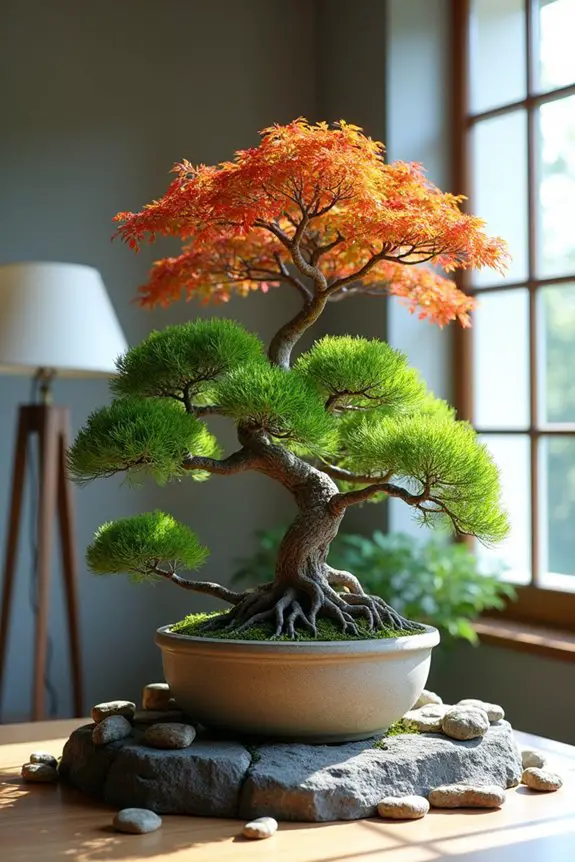
Miniature trees can truly create a breathtaking focal point in any space, but how about taking it a step further with some clever arrangements? Using bonsai trees as striking accents, whether alone or in groups, can elevate the overall aesthetic while keeping the vibe serene yet enchanting.
It’s like having your own personal forest in the comfort of your home—how cool is that?
Let’s plunge into some ideas for your mini forest. First off, think about tiered arrangements. Placing shorter bonsai in the foreground and gradually taller ones behind creates depth. It’s as if you’re artfully replicating a mountain landscape.
If you’re like me and lacking green thumbs, this layering can hide the little mistakes—like that one tree whose branches went a little too wild. Trust me, if it looks good, you’ll forget all about that.
Another effective technique is creating a themed display. Maybe you love the idea of a tropical vibe—pair a cascading banyan bonsai with a bright flowering variety for contrast.
Or, perhaps you’re feeling the autumn vibes with an arrangement of fiery red and amber leaves to set the mood. Let your trees share a story together. And let’s face it, a well-curated display can distract from the fact that you’re still figuring out how to care for them.
Don’t forget about stepping stones or gravel to organize your arrangement. Laying down some decorative stones can give your bonsai a scenic feel, evoking peaceful walks through a Japanese garden.
It also serves a practical purpose. Just like when I tried hosting my own dinner party, it’s important to keep things neat while still looking interesting—which, let’s be honest, doesn’t always happen when I’m in the kitchen.
Lastly, make sure to adjust the lighting. If you have a favorite tree, let it have the spotlight—literally. Position it where natural light gently beams on it or use a strategically placed lamp to showcase those delicate branches.
This won’t only help with its growth but also make it look like the star of the show.
5. Bonsai Display Techniques
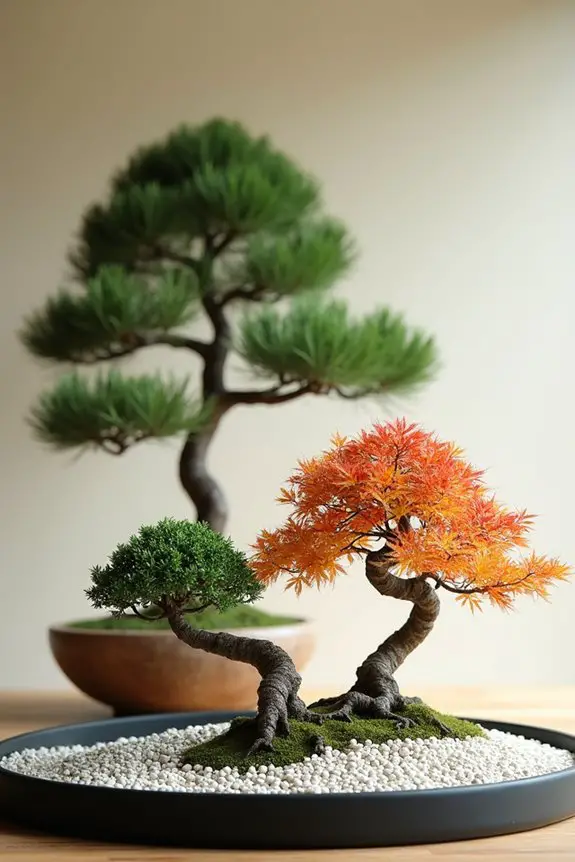
When it comes to displaying your bonsai, the right arrangement can transform your space into an artistic zen retreat. Think of this not just as decoration but as a way to tell a story—they’re little worlds unto themselves, each conveying its own set of vibes and emotions. Who wouldn’t want a slice of serenity at home?
First, let’s consider the power of height—layering those bonsai trees is key! Place shorter, charming varieties in front, with taller ones in the back. It’s like organizing a cute little bonsai army, all lined up for a peaceful mission. This technique not only looks stunning, but it also cleverly disguises any less-than-perfect pruning job. Trust me, it’s great for giving your space a professionally curated look, even if your gardening skills are still a work in progress.
Next, let’s get thematic. Have a passion for tropical escapes or perhaps you fancy the rich hues of autumn leaves? Create a mini display that embodies that theme. Pair bold, colorful trees with softer, more delicate ones, bringing that vibrancy to life. It’s similar to planning a meal where you mix flavors—some sweet, some spicy—with the aim to create a delightful experience. Just think of it as bonsai cuisine, where presentation is half the meal.
And don’t neglect the ground beneath your mini forest! Choosing to lay down some gravel or decorative stones can give your arrangement definition and character, much like a good plate presentation at a fancy restaurant.
And let’s face it, we could all use a little help keeping things neatly organized. If only I could do the same with my sock drawer.
Finally, lighting! This is your chance to make a bonsai feel like a superstar. Set it up for success by placing it where it can catch some natural light, or spotlight it with a cute lamp. A well-lit bonsai doesn’t just grow better; it shines like it’s ready for the red carpet.
And if you’re having a rough day, sometimes all it takes is to sit and admire your little tree as it basks in its glory.
6. Bonsai Integration Techniques
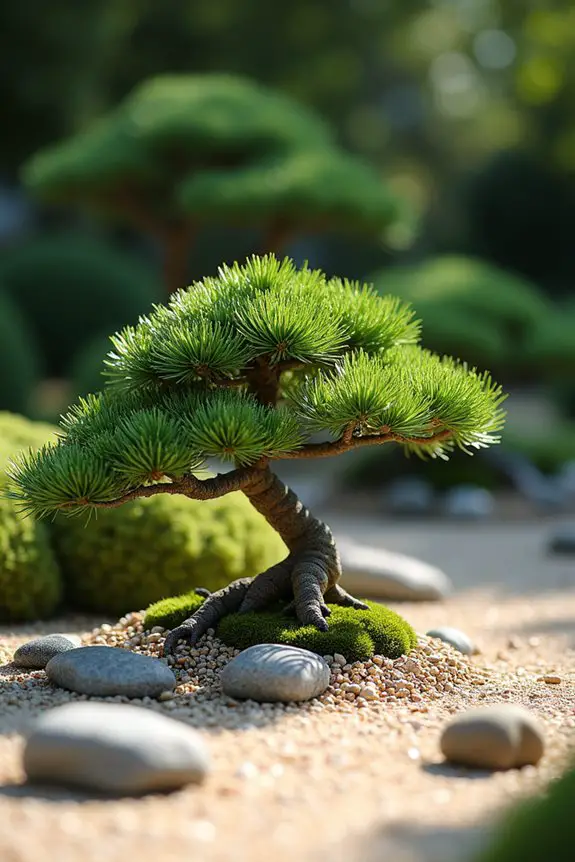
Integrating miniature trees into your garden design can elevate your space while making it feel both artistic and serene. It’s like creating a mini-ecosystem where every little plant plays a role in the overall narrative. Plus, they fit snugly into small areas, allowing you to enjoy a lush green vibe without the hefty landscape commitment.
Start with selecting your trees. Think about a balance of heights—maybe a lush juniper in the center, flanked by delicate azaleas. It’s like assembling a charming family portrait, where each member complements the other. Remember, you want to avoid overcrowding, so give each bonsai room to breathe. No one wants to be the stuffed teddy bear in the corner, right?
Next, consider the ground. Laying down a simple foundation of gravel or decorative stones can make a world of difference. It’s not just practical for drainage; it sets a peaceful stage for your trees to shine. Almost like putting on a clean tablecloth before serving a meal—the presentation matters.
And honestly, a neat space makes my heart do a little happy dance.
Now, let’s chat about placement. Position your bonsai so they catch some natural light, like they’re soaking up the sun on their summer vacation. If you’re feeling extra, a small spotlight can make them shine like stars in a night sky. I once thought a bare corner was the perfect spot—but trust me, a well-lit display transforms everything.
Finally, don’t forget the little details. You could add some small rocks next to your trees—those tiny nuggets act like the cherry on top. They bring texture and interest to the arrangement, and let’s face it, who doesn’t like a little whimsy?
7. Zen Garden Layout
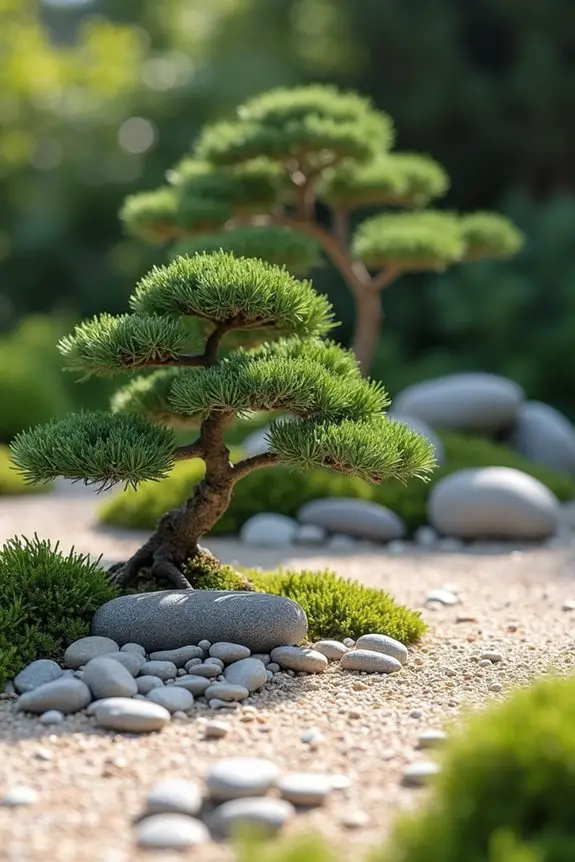
Creating a Zen garden layout with miniature trees is like painting a calming picture on a small canvas. These vibrant little plants add not just beauty but a sense of tranquility and balance that completes the spirit of a Japanese garden.
Imagine stepping into your yard and feeling the burden of the day melt away as you immerse yourself in pure serenity.
To start, choose your miniature trees wisely. Think about the personalities of each tree. Do you want the strong presence of a stout bonsai pine or the delicate flow of a weeping juniper? Mixing different species can create a mesmerizing scene, but keep it simple—too many varieties might look great on paper but can turn your garden into a botanical traffic jam.
Trust me, your trees will thank you for a little breathing room.
Next up, let’s talk about the layout. Start by mapping out an area for your miniature trees, perhaps in a corner of your yard where they can bask in sunlight. Position taller trees towards the back, so they don’t overshadow their smaller siblings.
This layering creates a lovely visual flow. Think of it like a family gathering where the tallest relatives stand in the back row of a photo—everyone can see the tiny ones up front, right?
Now, think about the surrounding elements. Gravel or sand can serve as the perfect base, mimicking the soothing sounds of rippling water. Rake some patterns in the gravel to keep it engaging while also providing a sensation of calm.
I tried this once with a patterned rake design, picturing myself as a Zen master. Let’s just say it was a little more abstract than I’d hoped, but you can definitely achieve something beautiful, promise!
Finally, sprinkle in some smaller stones around your trees for that whimsical touch, as if nature decided to accessorize.
These little guys aren’t just decoration—they help with drainage and stability. Plus, they can be a conversation starter, “Oh, did you see how those tiny rocks just tie everything together?”
Trust that friends will appreciate your inner landscape architect, even if you secretly feel more like a child playing in a sandbox.
To sum it up, a Zen garden featuring miniature trees isn’t just functional but also a heartfelt expression of peace and beauty. Embrace the process, and who knows, you might just become the local garden guru.
8. Pathway Layout Integration
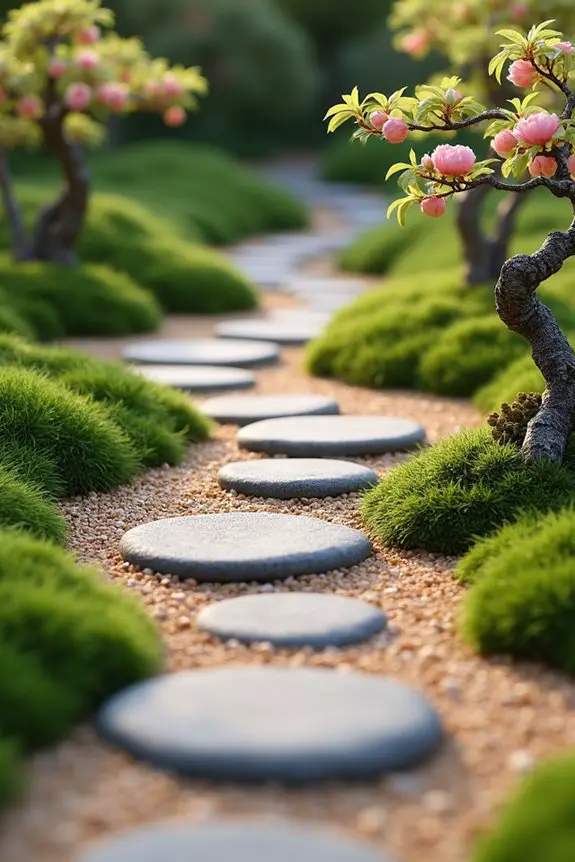
Creating a pathway layout that integrates miniature tree arrangements is like carving a mindful journey through your own little landscape. The right path not only guides your visitors but also envelops them in that soothing, Japanese garden atmosphere. It cultivates a harmonious flow that invites exploration while keeping everything looking tidy and intentional.
First things first, let’s pick out those stepping stones. You want them nice and flat, like nature’s version of a red carpet, leading you right into the heart of your garden. Spread them out a bit, creating a meandering path that beckons you forward. This isn’t a race—take your time! Imagine the quiet joy of strolling along, listening to the gentle rustling of leaves as you walk.
Next, think about the spacing between your stones. Aim for a comfortable stride. You don’t want to do an awkward hop, skip, and jump just to reach the next step. A foot or two apart is ideal. This not only makes it inviting but also gives you time to appreciate the delicate details of your miniature trees tucked in nearby.
Now, let’s get creative with your gravel and soil. A gravel pathway, edged with tiny pebbles, mimics those serene Japanese beaches. Rake the gravel for some patterning—swirling lines, gentle waves—it’s all about bringing that Zen feeling into your steps. If you can’t seem to make it look right, don’t sweat it. I once thought I’d create a masterpiece and ended up with a pile of rocks that looked more like modern art than Zen. Trust me, it’s the calm you’re after, not the perfection.
And don’t forget to reflect on those miniature trees while laying out your path. Position them close enough so they can be appreciated up close, but far enough that they don’t block the way. They’re your garden’s stars after all, so let them shine! A bit of thoughtful arrangement can make the whole space feel balanced, as if it was designed by a professional, even if you’re just a weekend gardener.
Lastly, don’t rush to fill every inch of space. Sometimes, less is more, and allowing some blank area to breathe can enhance the overall experience. It’s like keeping a little mystery in your garden—inviting curiosity and calming the mind. Who needs chaos when you can step into a peaceful retreat, right?
In the end, integrating a pathway layout with miniature trees turns your yard into an invitation for serenity. So grab those tools, let that creativity flow, and before you know it, you’ll be enjoying peaceful strolls through your very own Japanese escape.
9. Tranquil Water Feature Placement

When it comes to creating a tranquil atmosphere in your garden, the placement of a small water feature can make a world of difference. Now, why does this idea work so well? For starters, water brings a rejuvenating quality to any landscape. The gentle sound of trickling water instantly soothes the mind—like a mini meditation retreat, right in your backyard.
Plus, when paired with miniature trees, it offers a beautiful contrast, creating a serene oasis that makes you want to linger a bit longer.
So let’s explore the how-tos of placing your water feature. First off, think about size. Since we’re working with a cozy space, opt for something small, like a cute pond or a simple basin. Ever seen one of those tabletop fountains? They’re adorable and can fit snugly among your miniature trees. You want it to feel like a hidden gem, not an overwhelming centerpiece.
Next, consider positioning. A good rule of thumb is to place your water feature where it can be easily seen from different angles. For example, if you have a spot that’s visible both from your patio and while walking the path, that’s golden.
And you know what? I once chose a spot that was only visible when I was squinting through a bush—trust me, don’t be that gardener.
While placing it, think about accessibility too. You might want to easily pop by and give it a little clean now and then—or, let’s be real, you might just need to check on the water levels. Place it close enough for maintenance but far enough that it doesn’t impede your meandering path.
Don’t skimp on the surrounding details either. Consider adding moss or smooth pebbles around the water feature. This can create a soft shift from water to land, giving it a natural feel.
I once thought about adding bright colored stones around mine—turns out, they looked more like a candy store than a Zen garden. Go for subtlety; it doesn’t need to be a dazzling show.
Lastly, let’s not forget lighting. If you’re lucky enough to have a low-light feature, you can sprinkle some solar lights around. Watching the water glisten softly under the moonlight? Pure magic.
I tried fairy lights once, and it turned into a lighting spectacle that could rival a Christmas display.
In short, placing a tranquil water feature with your miniature trees doesn’t just elevate your garden – it creates a peaceful retreat.
10. Bonsai Aesthetic Harmony
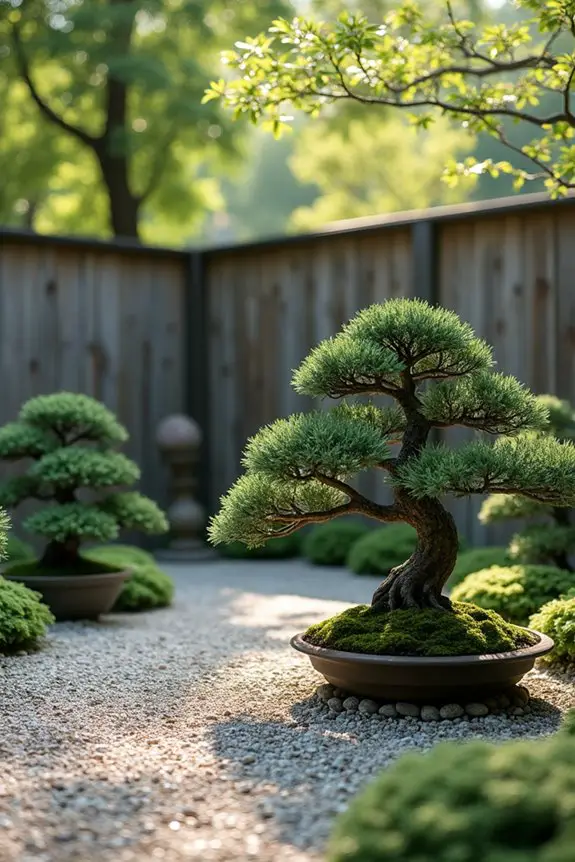
When it comes to creating a cohesive look in your Japanese garden, incorporating miniature trees like bonsais is a game-changer. Not only do they fit perfectly in tight spaces, giving you that artistic flair without overwhelming the area, but they also embody the elegance of traditional Japanese landscapes. Think of them as the small but mighty stars of your garden—they may be petite, but they pack a punch in beauty and tranquility.
Now, let’s talk about arranging these bonsai trees for maximum aesthetic harmony. First off, consider the visual height. Place taller trees toward the back or center of your little garden space, allowing shorter varieties to gracefully spill over the edges. It’s a bit like tiering a cake; you want to create layers that draw the eye and invite curiosity. I once arranged my trees haphazardly, and let me tell you, my garden looked less like a peaceful retreat and more like a toddler’s art project gone rogue.
Next, think about the shapes and styles of your bonsai. Mix a few different species but keep it simple—maybe one or two types with similar foliage colors or textures. That can help create an easy-going flow, making your garden feel like a calming oasis rather than a chaotic jungle. I learned this the hard way after an ambitious attempt at diversity that ended up looking more like a weird botanical collage.
Placement is key, too. Try to position your bonsai in a way that they seem to ‘talk’ to each other, creating a sense of connection. Maybe group them in clusters, with pathways or gravel lanes giving visual breathing room between them. This draws eyes along the journey, making you want to pause and inhale the serenity. I definitely had my own cluster of mismatched trees looking like they were caught in a mid-conversation battle. Trust me, that’s not the vibe you want.
And don’t forget to layer in your textures! Adding a thin layer of gravel or using smooth pebbles around the base of your trees can create that clean, polished look while also giving a nod to the Japanese aesthetics of simplicity and calm. I once thought it would look cool with brightly colored stones, only to discover that my garden suddenly resembled a jigsaw puzzle—yikes.
Finally, maintain those bonsais! A little pruning here and there keeps them looking their best and guarantees they don’t turn into a wild thicket. Regular trimming also enhances the light, airy feel, preventing them from crowding. Just remember, practice makes perfect, and if you accidentally snip too much off, hey, that’s just nature’s way of reminding you they’re resilient.
Use Natural Lighting Effectively
How can you use natural lighting to enhance your Japanese garden? Think of it like adding seasoning to a dish; it can make all the difference.
For your small Japanese garden ideas, position your plants strategically to soak up sunlight. Let shadows dance over gravel paths created by those thinly pruned trees, creating intriguing patterns that invite guests to explore.
Strategically position your plants to soak up sunlight and create captivating shadow patterns that beckon exploration.
Consider planting evergreens where they’ll catch the golden morning sun, casting a calming glow. If you’ve got boulders or stones, let the light highlight their textures.
How about incorporating a small water feature? The way light reflects off the water is simply magical, like nature’s own disco ball. Embrace that natural lighting—it’s your garden’s secret ingredient.

